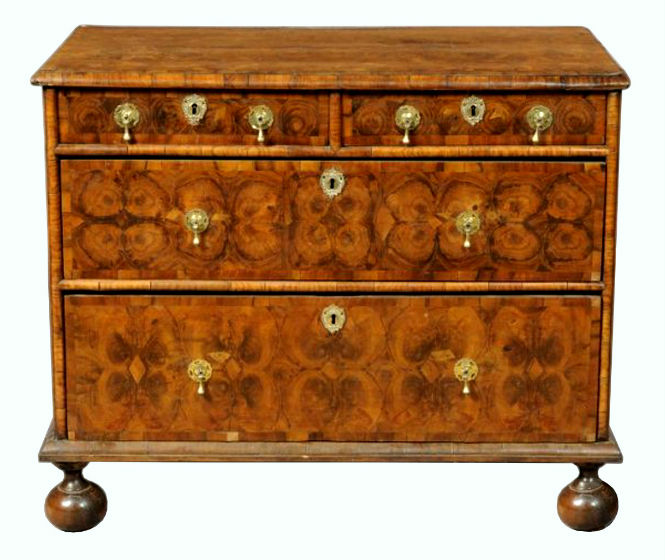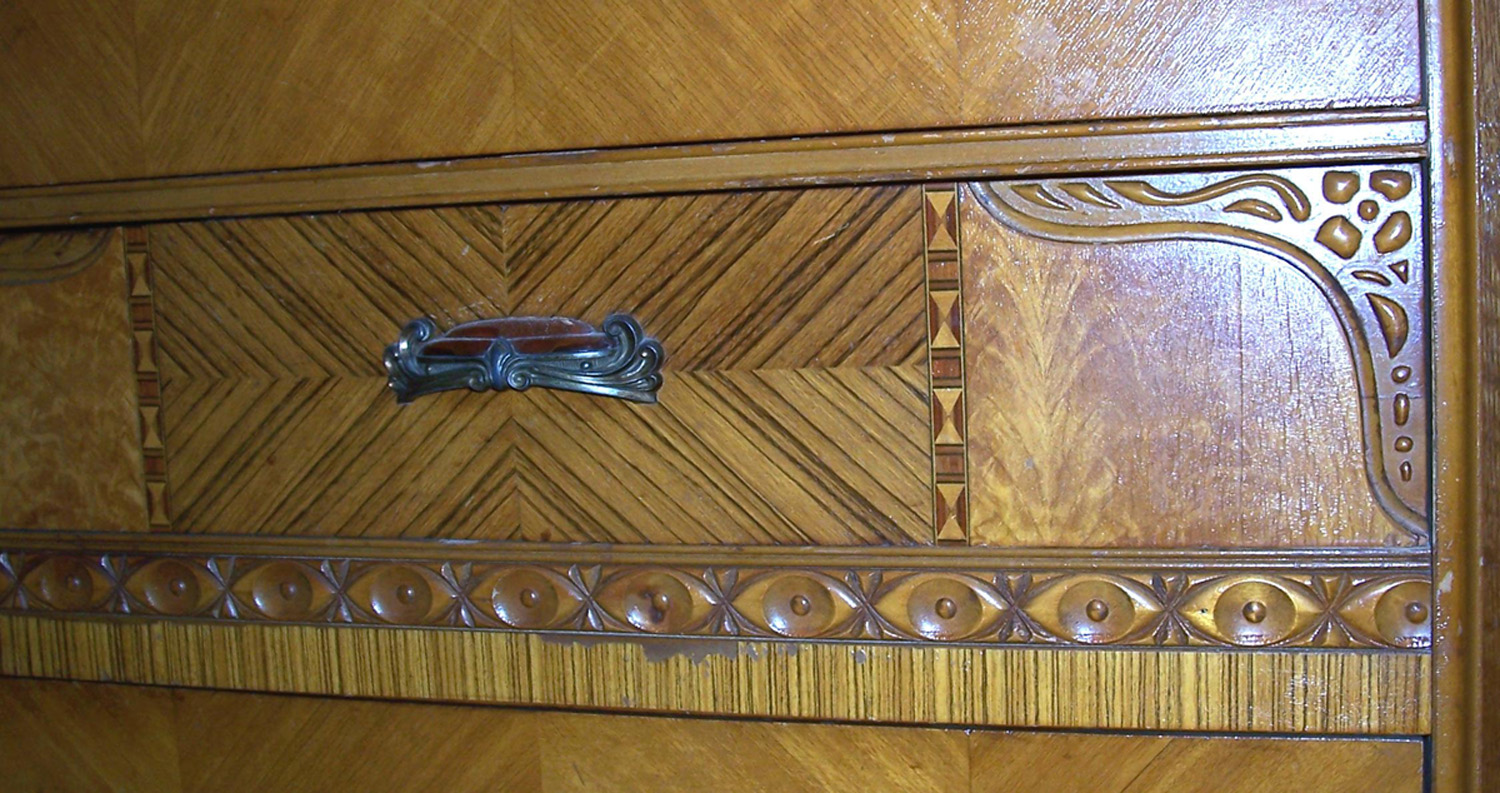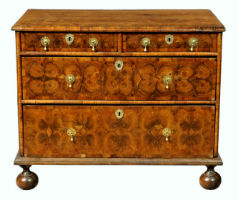
CRYSTAL RIVER, Fla. – In the last 50 years or so veneer has gotten a bad rap in the furniture trade. Somehow, back in the 1960s and 1970s veneer became associated with, and in many cases actually blamed for, some of the absolute garbage that was being manufactured at the time. But it probably goes back farther than that. That attitude is a holdover from the Depression era that is lodged in the minds of the children of the time. They remember some of the furniture their parents bought back in those dark days.
That period of furniture manufacturing, the first half of the 20th century, and particularly the 1930s and 1940s, saw some of the best furniture ever built anytime, anywhere by anybody – but it also saw some of the worst, like the infamous “borax” or “veneerite” furniture, and that is the vision that lingers.

That 70-year-old bad taste has resulted in several urban legends related to veneer that are now regarded, in many quarters, as common wisdom. Among them are:
- The mere presence of veneer on furniture is a guarantee of inferior quality.
- That same veneer indicates that the furniture is of modern construction.
- When “cheap” veneer chips or cracks, its best to just get rid of it and finish the solid wood that’s underneath because everyone knows that.
- Veneered furniture cannot be stripped, sanded and refinished.
These homilies turn out to be a lot more “common” than they are “wisdom.” The practice of cutting thin sheets of wood from a block or log and applying them to a surface is a difficult art, yet one that has been around for thousands of years. Remnants of furniture from tombs indicate the ancient Egyptians certainly knew the practice and the Romans were adept at it also. The Romans had a real advantage – they figured out the concept of offsetting the teeth in their saws which allowed for much more efficient cutting.
But what are the advantages of such a mechanically difficult process – a cutting veneer and applying it to otherwise perfectly sound furniture? The answer is threefold: artistic, environmental and structural.
ARTISTIC
The art of veneering pretty much died out after the Romans and did not reappear until a thousand years later at the time of the Italian Renaissance in the 14th and 15th centuries. This time it was seen primarily as marquetry inlay for decorative purposes.
It took the perfection of the panel saw in the 17th century (by the Dutch) to make the veneering an entire surfaces a practical matter. And from then on the history of veneer is very much the history of the technology of the saw. Toward the end of the William and Mary period in the late 1600s and early 1700s a new great age of veneering began and the art soared high for the next century and a half.
Thomas Chippendale, George Hepplewhite and Thomas Sheraton took advantage of the possibilities of veneer in a great many of their designs. So did the ebenistes of Regence France before them early in the 18th century and the architects of the French Empire after them early in the19th century. American Empire and Late Classicism followed suit until the practice fell into general disuse, with a few notable exceptions including John Henry Belter, for the duration of the Victorian era. A pity, since right about the time large-scale veneering went of favor the mechanical slicing blade was introduced which replaced rotary saws for producing ever thinner sheets of veneer. Wholesale veneering did not return until early in the 20th century when conservation of America’s timber resources became an issue.

It was the use of veneer that allowed the first great furniture movement of the 20th century, Art Moderne (later to be known as Art Deco, a term not coined until the 1960s) to make its debut at the Paris Exposition in 1925. Only veneering techniques could produce the striking contrasts of patterns, angles and colors achieved by Art Moderne in the 1930s and 1940s.
Utilizing thin sheets of wood is the only way to display the beauty of some woods like burls and crotch cuts, which are too unstable to be used in solid form. Since no two trees grow exactly alike and since no two boards are ever cut identically, veneer is the only way to create some of the patterns we have come to expect in quality furniture. Repeating patterns, book matches, diamond matches and continuous grain patterns over all the drawers of a chest can only be created with veneer.
ENVIRONMENTAL
Theodore Roosevelt was at the leading edge of the conservation movement during his presidency from 1901 to 1908, bringing attention to the vast amount of water and timber being lost each year. In addition to furniture manufacturing another major player entered the hardwood market not long after World War I – the automotive industry. Early automobiles, including Model T’s, used a great deal of wood, primarily oak, in their construction. It was used in wheel spokes, dashboards, running boards and headliner supports. Even into the late 1920s Model A’s still used oak headliner material.
Better machinery and better glues developed for the war effort easily transferred to furniture making and the ability to slice expensive imported hardwoods like mahogany and increasingly scarce domestic wood quickly promoted the widespread use of ever thinner veneer cuts.
By the 1920s a typical hardwood face veneer had a thickness of 1/28 inch and underlying substrates were at 1/20 inch. This was a far cry from the hand cut panels of the 18th century, which were often 1/16 to 1/8 inch in thickness. By the 1960s many face veneers were down to 1/64 inch and some today are cut as thin 1/120 inch using computer- controlled, laser-guided cutting edges. This economical method of utilizing and conserving lumber resources hopefully ensures the future availability of the stock.

STRUCTURAL
Until the end of the 19th century, veneer was applied directly to a solid background and served strictly an ornamental function, having nothing to do with structural integrity. It seems odd that by slicing wood into thin sheets, the overall strength of the structure can be improved but that’s exactly what happens when layers of veneer are applied to each other with the grain patterns at a 90-degree angle to each preceding layer. By the turn of the 20th century three-layer plywood was being used as drawer bottoms and mirror backs instead of solid panels. Improved glues even allowed airplane propellers in World War I to be constructed of laminated sheets, attesting to the strength of the concept. But the three-layer variety was not yet strong enough to stand on its own.
That feat was accomplished with the development of “lumber core” plywood early in the 20th century. No longer could a piece of 1/8-inch mahogany veneer be slapped directly onto a pine surface. Modern veneer of 1/28-inch thickness would telegraph every small defect of the subsurface. As face veneers became thinner with advancing technology, the need for a smoother underlayment became apparent, and lumber core stock solved both the structural problem and the aesthetic one.
The process started with a solid core of gum or poplar, in some cases even glued up sections of oak. This core was approximately the thickness of the final panel, e.g. just under 3/4 inch. Then layers of a smooth subveneer, also gum or poplar, were laid on each side of the core with alternating grain patterns. These sub layers were about 1/20 inch. A final layer of an inexpensive veneer on the bottom and a hardwood face veneer on the top finished off the process. The result was a panel that looked like solid walnut or mahogany but used less than 5 percent of the scarcer wood that would have been required to make a solid panel.
But the real payoff was in the strength of the panel. This laid up piece was 80 percent stronger than an equivalent piece of solid hardwood, not having the weakness along the grain line exhibited by solid wood. In addition it was not subject to the same shrinkage pattern across the grain as was the solid panel. It would stay straighter longer than solid wood. The majority of furniture built in the first half of the 20th century employed this lumber core concept in drawer fronts, tabletops, doors and other load-bearing surfaces. Less stressful locations like side and back panels continued to be three-layer ply.
By the late 1950s another substrate came into play – particle board. This manufactured wood product could be formulated to any thickness and rolled to a surface smoothness unachievable in solid wood and in many cases eliminated the need for subsurface veneers. This artificial surface accommodated the 1/64-inch new generation of veneers until it was replaced by an even higher technology product – medium density fiberboard.
MDF, as it’s commonly called, is the latest furniture construction material, consisting of highly compacted fibrous material (essentially cardboard) with a density many times that of most wood. Thus it is possible to look at a modern cabinet that appears to be solid mahogany or walnut yet contains almost no wood of any kind other than veneer and the required rails and stiles.
Perhaps that is why so many of us are attracted to antiques as the possibility of the recurrence of the furniture nightmares of the 1930s looms over us.
___
By FRED TAYLOR
Send comments, questions and pictures to Fred Taylor at P.O. Box 215, Crystal River, FL 34423 or email them to him at info@furnituredetective.com. Visit Fred’s newly redesigned website at www.furnituredetective.com and check out the new downloadable “Common Sense Antiques” columns in .pdf format.
His book “How To Be a Furniture Detective” is available for $18.95 plus $3 shipping. Send check or money order for $21.95 to Fred Taylor, P.O. Box 215, Crystal River, FL 34423.
Fred and Gail Taylor’s DVD, “Identification of Older & Antique Furniture” ($17 + $3 S&H) is also available at the same address. For more information call 800-387-6377 (9 a.m.-4 p.m. Eastern, M-F only), fax 352-563-2916, or info@furnituredetective.com. All items are also available directly from his website.




